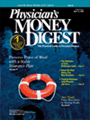Publication
Article
Physician's Money Digest
Put This Year's Tax Refund to Good Use
With lower federal tax ratesinstituted in 2003, Americanhouseholds are expected toreceive larger than normal refunds thisyear. If you're like many Americans,you'll spend most or all of that refundinstead of saving it, investing it, or payingdown debt.
In February 2003, the CambridgeConsumer Credit Index conducted a taxpayersurvey. The survey asked taxpayerswhat they planned on doing withtheir income tax refunds. At the time,28% planned to put the money in abank account, 23% were going to payoff bills, 19% were going to pay offcredit cards, 9% were going to spendthe extra money on everyday items, and6% were going to invest their refund instocks and bonds.
The results:
In December 2003, the CambridgeConsumer Credit Index conducted a follow-up survey to see how taxpayers actuallyspent their refunds. Only18% put their money into a bankaccount, 33% paid off bills, 20% spentthe money on everyday items, 15% paidoff credit cards, and 2% invested theirmoney in stocks and bonds. Before youdecide how you're going to spend thisyear's refund, consider taking full advantageof the extra money. Following areseven ways to make your income taxrefund work for you:
1) Reduce high-interest debt. Thosetaxpayers (15%) from the CambridgeIndex survey who reduced their creditcard debt had the right idea. Put thatrefund toward a credit card balance carryinga 14% interest rate and you'veguaranteed yourself a 14% return onyour money. And keep it paid down onceyou do. The truth is lowering high-interestconsumer debt is one of the bestfinancial moves you can make today.
2) Establish an emergency fund.Nearly 60% of American householdswith children under age 18 live paycheckto paycheck, according to a recentsurvey by MetLife. A "rainy day" fundto meet emergencies would be welcomenews for them.
3) Invest in your retirement plan.Let's say you receive an $800 tax refundand put that money into your 401(k).You will immediately earn another $400if your employer matches 50 cents foreach dollar you contribute. You'll doubleyour contribution if the employer kicksin a $1 match. That's a lot of bang foryour refund.
No 401(k) plan or other employersponsored plan at work? No problem.There are always IRAs. If you've alreadycontributed the maximum amountallowed for the year, consider tax-efficient mutual funds or annuities. The self-employedhave even more options,including solo 401(k)s, simplified employeepension plans, and Keogh plans.
4) Put it toward college. Invest in acollege savings account for your children.The younger they are, the moreyears the refund will have to grow.Consider investing in a 529 CollegeSavings plan, Coverdell Education SavingsAccount, or US savings bonds.
Note:
5) Make an extra mortgage payment.Knocking off a chunk of yourmortgage principal can save you thousandsin interest over the long run. Butaccelerating mortgage payments isn'talways the best move for homeowners; itdepends on your current mortgage rateand investment alternatives. Before you decide this is how you wantto spend your tax refund, consider consultinga financial planner or advisor.
6) Buy additional or new insurance.Do you need additional disability insurancecoverage or perhaps long-term careinsurance? While you will need to keepup the premiums in subsequent years,this year's income tax refund can get youstarted on the right track.
7) Have fun. Of course, you canalways keep a little of your refund foryourself. Have fun with it. Decide tospend it on something that you wantinstead of need.
This article has been produced by the FinancialPlanning Association (www.fpanet.org), themembership organization for the financial planningcommunity.
